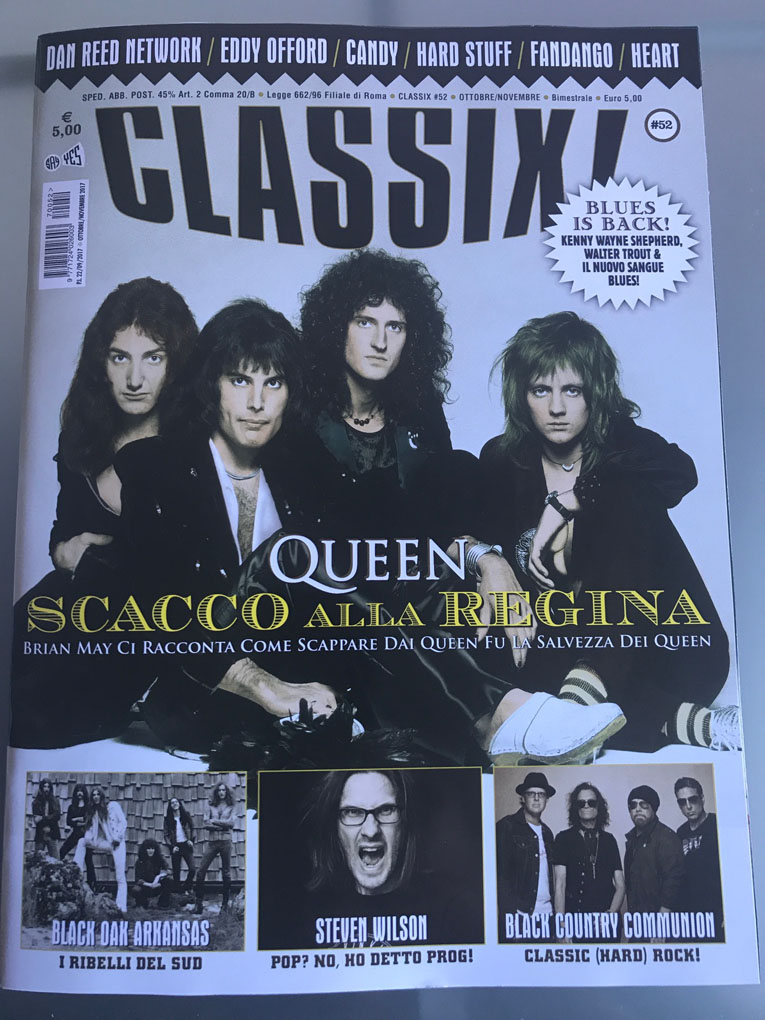Italian fans….
Queen grace the cover of Italian magazine Classix! October-November 2017 issue, 22/09/2017. “Queen in 3-D” is the lead story. (ENGLISH TRANSCRIPT – our thanks to Barbara Mucci – followed by the article in ITALIAN language.

ENGLISH TRANSCRIPT:
BRIAN MAY – ‘QUEEN IN 3-D’
By Tony Aramini – Classix! Magazine
Oct-Nov 2017
Translated by Barbara Mucci
Let’s start with some technical information. Stereoscopy is a photographic technique, which produces two images of the same subject taken from slightly different angles, simulating the points of view of the two human eyes. These pairs of photographs, viewed through a special viewer (stereoscope), create an impressive three-dimensional effect. Strangely enough, this is a technique older than photography itself that, after decades of attempts, was perfected in the mid-nineteenth century using pairs of drawings.
Brian May has discovered stereoscopy when he was a child thanks to a couple of complimentary cards inside a cereal box. From the back of that pack, he filled a coupon to order, at the price of one shilling and a halfpenny, the appropriate viewer. Little Brian was astonished to receive the keenly awaited parcel: through those lenses, the hippos depicted on those cards took magically life, turning into three-dimensional images. He didn’t know it yet, but he had just found a passion that would have marked his life forever, second only to that electric guitar that would have given him honour and glory with Queen. Caught up in the excitement, he began to experiment with that ingenious technique, with his simple camera, taking pictures from slightly misaligned perspectives: although it was a rudimentary method, it worked. They were the first of many stereographs taken by Brian May who, over the years, would cultivate the passion providing himself with the appropriate equipment, starting from dual-lens cameras. By demonstrating his sense of originality on this front too, May, despite all technological innovation, was not tempted by Polaroid’s immediate gratification but, even during the global success of Queen, he didn’t give up a flair for this particular kind of photography, taking dozens and dozens of images documenting Queen’s life both off stage and on stage (in fact, during their gigs, May often entrusted his stereoscopic camera to some collaborators placed to the side of the stage). Snaps being hidden for years in some drawer of his house. At least to this day….
In fact, this is the premise with which the luxurious “Queen In 3-D”, a huge coffee table book (with attached stereoscope) is born. It will make possible to everyone to admire the best of sixty years of snaps in three dimensions (copied from the original negatives when possible, and sometimes digitally cleaned to ensure the best quality): from the first free card found in a cereal box (“I don’t throw anything away”, May admits in a serious way. Thank goodness!) to the Queen World Tours in the 70s and 80s, until the recent tours with Adam Lambert behind the microphone.
But it’s more than that, because this not only is an aesthetically pleasing book but it is also interesting to read: all the photographic material is in fact accompanied by lines and lines written by Brian May himself, who, without a ghost-writer and with a sober and “confidential” style, indulges in memories, anecdotes and comments. Do not expect an autobiography or a classic biography about Queen. Although he follows a quite methodical timeline, May often jumps from one topic to another or deals summarily a few chapters of his long life story (artistic and personal) in favour of other ones, but here is the best part: he sounds like an old friend talking. This is obviously an essential appointment for all the staunchest Queen fans. Moreover, ‘Queen In 3-D’ is an interesting publication on many levels so that it can aspire to even reach a larger audience (photo enthusiasts, for example, may appreciate Brian May’s story about the evolution of the techniques used). The price, about fifty euros, is not ridiculous, but correct when compared to the quality of the finished product.
—
ITALIAN:
BRIAN MAY
‘QUEEN IN 3D’
(Ear Books/Edel, 256 pagine)
Partiamo da qualche informazione tecnica. La stereoscopia è una tecnica fotografica che produce due immagini di uno stesso soggetto riprese da angolazioni leggermente diverse, come a simulare i punti di vista dei due occhi umani. Queste coppie di fotografie, osservate attraverso uno speciale visore (stereoscopio), generano un suggestivo effetto a tre dimensioni. Strano a dirsi, ma si tratta di una tecnica più vecchia della fotografia stessa che, dopo decenni di esperimenti, è stata perfezionata a metà del XIX secolo, usando coppie di disegni.
Brian May la stereoscopia l’ha scoperta da bambino, grazie a un paio di cartoline in omaggio con un pacco di cereali. Dal retro di quel pacco compilò un coupon per ordinare, al prezzo di uno scellino e mezzo, l’apposito visore. Ricevuto l’agognato pacchetto, il piccolo Brian restò stupefatto: attraverso quelle lenti, gli ippopotami raffigurati su quelle cartoline presero agicamente vita, trasformandosi in immagini tridimensionali. Non lo sapeva ancora, ma aveva appena scoperto una passione che gli avrebbe segnato la vita per sempre, seconda solo a quella chitarra elettrica che gli regalerà onori e gloria in seno ai Queen. Preso dall’entusiasmo, iniziò a sperimentare quella portentosa tecnica scattando, con la sua semplicissima macchinetta, coppie di immagini riprese da prospettive leggermente disallineate: un metodo rudimentale, ma che funzionava. Furono le prime di tantissime stereografie scattate da Brian May, che nel corso degli anni coltiverà la passione munendosi di attrezzature adeguate, a partire dalle caratteristiche macchine con doppio obiettivo. Dimostrando la sua originalità anche in questo aspetto, May, pur attento ad ogni innovazione tecnologica, non si fece tentare dalla immediata gratificazione delle Polaroid, ma, anche durante il successo planetario dei Queen, non abbandonò il gusto per questo particolarissimo tipo di fotografia, scattando decine e decine di immagini che documentarono la vita della “regina” sia off stage che on stage (May infatti durante i concerti affidava spesso la sua fotocamera stereoscopica a qualche collaboratore piazzato a bordo palco). Scatti rimasti per anni in qualche cassetto di casa sua. Almeno fino ad oggi. È questo infatti il presupposto con cui nasce il lussuosissimo tomo ‘Queen In 3D’, un enorme offee table book (con stereoscopio allegato) che permetterà a tutti di ammirare in tre dimensioni il meglio di sessant’anni di scatti (riprodotti dai negativi originali quando possibile e talvolta ripuliti digitalmente per assicurare la migliore qualità): dalla primissima cartolina trovata in omaggio coi cereali (“Non butto via niente”, ammette significativamente May. E meno male!) alle tournée mondiali dei Queen anni ’70 e ’80, fino alla recente incarnazione con Adam Lambert dietro il microfono.
Ma c’è di più, perché non si tratta di un volume solo bellissimo a vedersi, ma anche altrettanto interessante da leggere: tutto il materiale fotografico è infatti accompagnato da righe su righe scritte di proprio pugno da Brian May, che, senza ghost writer e con uno stile sobrio e “confidenziale”, si lascia andare a ricordi, aneddoti e commenti. Non aspettatevi, però, un’autobiografia o una classica biografia dei Queen. Pur seguendo una linea cronologica abbastanza ordinata, May spesso salta di palo in frasca o tratta sommariamente alcuni capitoli della sua lunga storia (artistica e personale) in favore di altri, ma il bello è anche questo: sembra quasi di sentir parlare un vecchio amico. E se per i fan più affezionati si tratta di un appuntamento ovviamente irrinunciabile, c’è da aggiungere che ‘Queen In 3D’ si dimostra una pubblicazione interessante su così tanti livelli da poter ambire a un pubblico persino più nutrito (da appassionati di fotografia, per esempio, potreste apprezzare non poco il racconto di Brian May sull’evoluzione delle tecniche adoperate). Il prezzo, attorno alla cinquantina di euro, non è irrisorio, ma assolutamente corretto se rapportato alla qualità del prodotto finito.
(Tony Aramini)
—
Please also check out Brian May’s Unboxing Italian “Queen in 3-D” book video.
And Brian’s commentary HERE
